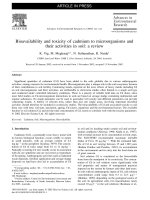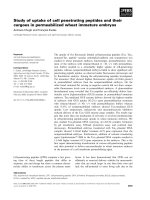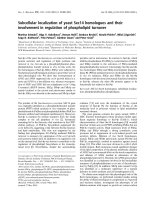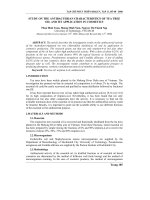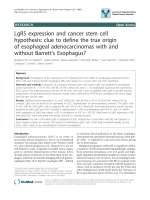The ancient origin of NF kb ikb and thioredoxin and their roles in immune response
Bạn đang xem bản rút gọn của tài liệu. Xem và tải ngay bản đầy đủ của tài liệu tại đây (2.89 MB, 197 trang )
THE ANCIENT ORIGIN OF NF-κB/IκB AND
THIOREDOXIN AND THEIR ROLES IN IMMUNE
RESPONSE
WANG XIAOWEI
(Master of Science)
A THESIS SUBMITTED
FOR THE DEGREE OF DOCTOR OF PHILOSOPHY
DEPARTMENT OF BIOLOGICAL SCIENCES
NATIONAL UNIVERSITY OF SINGAPORE
2006
i
Acknowledgements
I would like to express my deepest gratitude to Prof. Ding and Prof. Ho for giving me the
opportunity to work on this project. They have provided excellent guidance and support
throughout my years in the lab. From them, I have learnt many invaluable skills that are
essential for my future career.
I would like to thank especially Dr. Andrew Tan and Dr. Liou Yih-Cherng for giving me
countless advices and suggestions for my Ph. D study. I would also like to thank Prof.
Sheu Fwu-Shan, Dr. Lu Jinhua for their help in DLR experiments and Prof. Wasserman,
Prof. Dan Hultmark for providing antibodies.
I also would like to express my gratefulness to my current and previous lab mates: Li
Peng, Naxin, Baozhen, Zehua, Patricia, Li Yue, Belinda, Siou Ting, Wang Jing, Lihui,
Zhu Yong, Weidong, Alvin, Xiaolei, Sun Miao, Nicole, Hanh, Derrick and Sandra.
Without them, I would not have such an enjoyable time in the lab.
Many thanks also go to Suhba for her help and Shashi, Qingsong and Michelle who have
helped me with my analysis of the mass spectrometry data.
I would also like to thank the National University of Singapore for the Research
Scholarship award and A*STAR BMRC grant for financial support.
Most importantly, I would like to thank my family for their love, understanding and
encouragement, which make the lonely time studying overseas bearable.
THANK YOU!
ii
Table of Contents
Page
Acknowledgements i
Table of Contents
ii
Summary
v
List of Tables
vii
List of Figures
viii
List of Abbreviations xi
List of Primers
xv
An Overview of Objectives, Approaches and Findings in This Study xvii
CHAPTER 1: INTRODUCTION 1
1.1 The innate immune system 1
1.1.1 The innate and adaptive immunity 1
1.1.2 Recognition of pathogens by pattern recognition receptors 2
1.1.3 The innate immunity of invertebrates 3
1.2 The NF-κB signaling pathway 5
1.2.1 Introduction to the NF-
κ
B signaling pathway 5
1.2.2 NF-
κ
B signaling pathway in Drosophila 11
1.2.3 Evolution and conservation of NF-
κ
B signaling pathway 15
1.2.4 TLR/NF-
κ
B signaling pathway in C. elegans 16
1.2.5 Some clues on the possible existence of NF-
κ
B signaling pathway in the
horseshoe crab 18
1.3 Thioredoxins and their roles in regulating immune response 19
1.3.1 Reactive oxygen species (ROS) and antioxidant system 19
1.3.2 Thioredoxin superfamily 21
1.3.3 The influence of TRX in NF-
κ
B signaling pathway 24
1.3.4 The thioredoxin family in arthropods 26
1.4 The horseshoe crab as model for innate immunity study 28
1.4.1 Horseshoe crab is a “living fossil” 28
1.4.2 Advantages of using horseshoe crab for innate immunity research 28
1.4.3 Horseshoe crab possesses a powerful innate immune system 30
1.5 Objectives and experimental approaches 37
1.5.1 Objectives of this project 37
1.5.2 Experimental strategies 37
CHAPTER 2: MATERIALS AND METHODS 39
2.1 Organisms and Materials 39
2.1.1 Organisms 39
2.1.2 Biochemicals, enzymes and antibodies 39
iii
2.2 cDNA cloning of targeted molecules 40
2.2.1 Infection of horseshoe crab and RNA extraction 41
2.2.2 Cloning of CrNF
κ
B, CrI
κ
B and CrRelish 43
2.2.3 Cloning of PCR products and sequencing 44
2.2.4 Isolation of full length cDNA by RACE PCR 45
2.2.5 Phylogenetic analysis of target molecules 46
2.2.6 Transcriptional profiling upon Pseudomonas infection 46
2.3 Functional characterization of CrNFκB and CrIκB 47
2.3.1 Construction of expression vectors 47
2.3.2 SDS-PAGE & Western Blot 49
2.3.3 Pull-down assay for protein-protein interaction analysis 50
2.3.4 Immunoprecipitation assay 50
2.3.5 Electrophoretic gel mobility-shift assay (EMSA) 51
2.3.6 Cell culture and transfection 54
2.3.7 CAT and
β
-Gal ELISA assay 55
2.3.8 Immunofluorescence 55
2.3.9 Inhibitor treatments and reverse-transcription PCR 57
2.4 Functional characterization of Cr-TRX1 59
2.4.1 Construction of plasmids 59
2.4.2 Site-directed mutagenesis of Cr-TRX1 60
2.4.3 Expression and purification of Cr-TRX1 61
2.4.4 Mass spectrometric analysis 62
2.4.5 Biochemical characterization of Cr-TRX1 63
2.4.6 Gene reporter assay 66
2.4.7 Non-radioactive electrophoretic mobility shift assay (EMSA) 67
2.4.8 Antioxidant inhibits NF-
κ
B signaling pathway 69
CHAPTER 3: RESULTS 70
3.1 Isolation of C. rotundicauda NF-κB and IκB homologues 70
3.1.1 Cloning and characterization of NF-
κ
B p65 homologue, CrNF
κ
B 70
3.1.2 Cloning of Cactus and I
κ
B homologue, CrI
κ
B 74
3.1.3 Cloning of horseshoe crab NF-
κ
B p100 and Relish homologue, CrRelish 79
3.2 CrNFκB binding to κB motif is inhibited by CrIκB 82
3.2.1 CrNF
κ
B binding to the
κ
B motif 82
3.2.2 CrNF
κ
B interacts with CrI
κ
B 85
3.2.3 CrI
κ
B inhibits CrNF
κ
B DNA-binding activity 88
3.3 Functional activation of the CrNFκB/CrIκB cascade 88
3.3.1 Overexpression of CrNF
κ
B activates
κ
B reporter expression 89
3.3.2 CrI
κ
B inhibits CrNF
κ
B transactivation ability 92
3.3.3 Subcellular localization of CrNF
κ
B and CrI
κ
B 93
3.4 Biological significance of a primitive CrNFκB/CrIκB cascade 95
3.5 Isolation and sequence analysis of the horseshoe crab TRX 107
3.5.1 Sequence analysis of Cr-TRX1 108
3.6 Biochemical characterization of Cr-TRX1 121
3.6.1 The spectral properties of Cr-TRX1 121
iv
3.6.2 Insulin reduction activity of Cr-TRX1 121
3.6.3 Reduction of Cr-TRX1 by mammalian thioredoxin reductase 123
3.6.4 The horseshoe crab thioredoxin functions as an antioxidant 124
3.7 Involvement of Cr-TRX1 in the NF-κB signaling pathway 127
3.7.1 Cr-TRX1 activates NF-
κ
B in HeLa cells 127
3.7.2 Biological significance of oxidative stress in the regulation of NF-
κ
B
signaling pathway 130
3.8 The 16 kDa TRX is conserved from C. elegans to human 132
3.8.1 Evolutionary conservation of 16 kDa TRX 132
3.8.2 Human TRX6, a homologue of Cr-TRX1, regulates NF-
κ
B DNA binding
activity 135
CHAPTER 4: DISCUSSION 139
4.1 The evolutionarily conserved NF-κB signaling pathway 139
4.1.1 The NF-
κ
B/I
κ
B signaling cascade of horseshoe crab is functionally
comparable to that of the Drosophila and mammals 140
4.1.2 A proposed NF-
κ
B signaling pathway in the horseshoe crab 142
4.2 The horseshoe crab Imd/Relish pathway 145
4.3 The activation of NF-κB signaling pathway in horseshoe crab 146
4.4 The exocytosis and NF-κB signaling 150
4.5 A novel form of TRX which regulates NF-κB activity 152
4.5.1 The 16 kDa Cr-TRX1 is functionally similar to the 12 kDa TRX 152
4.5.2 The 16 kDa TRX is conserved from C. elegans to human 153
4.6 The catalytic sequences of TRX families 155
4.7 The N-terminal extra cysteine residue of Cr-TRX1 156
4.8 The origin of the vertebrate 24 kDa TRXs 157
4.9 Cr-TRX1 regulates NF-κB signaling pathway 158
CHAPTER 5: CONCLUSIONS AND FUTURE PERSPECTIVES 162
5.1 Conclusions 162
5.1.1 NF-
κ
B/I
κ
B signaling cascade 162
5.1.2 The novel 16 kDa Cr-TRX1 and its role in NF-
κ
B signaling pathway 163
5.2 Future perspectives 163
BIBLIOGRAPHY 168
v
Summary
The NF-κB signaling pathway performs a pivotal role in the acute-phase of
microbial infection, by activating immune-related gene expression. The NF-κB
transcription factors are evolutionarily conserved from Drosophila to humans.
Unexpectedly, the canonical NF-κB signaling pathway is not functional in the immune
system of C. elegans. Therefore, the ancient origin of NF-κB signaling pathway is still
unknown. This project focused on tracing the ancient origin of the NF-κB signaling
pathway, characterization of its functions in innate immune response and regulation of its
activity by thioredoxin. To this end, the horseshoe crab was examined as this species
boasts >500 million years of evolutionary success.
This thesis reports the discovery and characterization of a primitive and functional
NF-κB/IκB cascade in the immune defense of a “living fossil”, the horseshoe crab,
Carcinoscorpius rotundicauda. The ancient NF-κB/IκB homologues, CrNFκB, CrRelish
and CrIκB, share numerous signature motifs with their vertebrate orthologues. CrNFκB
recognizes both horseshoe crab and mammalian κB response elements. CrIκB interacts
with CrNFκB and inhibits its nuclear translocation and DNA-binding activity. We
further show that Gram-negative bacteria infection causes rapid degradation of CrIκB
and nuclear translocation of CrNFκB. Infection also leads to an increase in the κB-
binding activity and up-regulation of immune-related gene expression, like inducible
nitric oxide synthase and Factor C, an LPS-activated serine protease. Altogether, our
study shows that, although absent in C. elegans, the NF-κB/IκB signaling cascade
vi
remained well-conserved from horseshoe crab to human playing an archaic but
fundamental role in regulating the expression of critical immune defense molecules.
In connection with the NF-κB mediated immune signaling, we discovered a
novel 16 kDa thioredoxin (TRX) from the horseshoe crab, designated Cr-TRX1. TRX is
a small ubiquitous protein-disulfide reductase, hitherto known to be conserved from
prokaryotes to human. This novel 16 kDa TRX is larger than the known classical 12 kDa
counterpart and contains an atypical WCPPC catalytic motif. Although Cr-TRX1
contains three Cys, only the two in its active motif are exposed and redox sensitive. Cr-
TRX1 possesses the classical thiodisulfide reductase activity, as indicated by the insulin
reduction assay and thioredoxin reductase assay. Additionally, Cr-TRX1 protected DNA
from reactive oxygen species-mediated nicking. Over-expression of Cr-TRX1 regulated
the expression of NF-κB-dependent genes by enhancing NF-κB DNA-binding activity,
suggesting possible roles of the Cr-TRX1 in modulating NF-κB signaling pathway. In
vivo, the antioxidant downregulated the expression of NF-κB controlled genes, such as
IκB and inducible nitric oxide synthase, which further supports our suggestion that
oxidative stress is a regulator of NF-κB signaling pathway, a phenomenon which has
been entrenched for several hundred million years. Furthermore, we demonstrated that
the 16 kDa TRXs are evolutionarily conserved from C. elegans to human. Interestingly,
thioredoxin-like 6, a human homologue of Cr-TRX1, could enhance the NF-κB DNA-
binding activity as well, suggesting that the NF-κB regulatory ability of the 16 kDa TRXs
is well conserved through evolution. (470 words)
vii
List of Tables
Table No. Title Page
Chapter 1
1.1
Defense molecules found in the horseshoe crab.
33
Chapter 3
3.1
The sequences used for phylogenetic analysis of the NF-κB and
IκB proteins.
78
3.2
Probes used in EMSA and binding characteristics of CrNFκB
and Dorsal to various probes.
85
3.3
The sequences used for phylogenetic analysis of the Cr-TRX1
and TRX6 proteins.
111
3.4 The list of trypsin digestion peaks of Cr-TRX1. 119
viii
List of Figures
Fig. No. Figure Title Page
Chapter 1
1.1
The family of mammalian NF-κB and IκB proteins.
7
1.2
Classical and alternative NF-κB signaling pathway.
10
1.3
The Drosophila NF-κB signaling pathway.
13
1.4
The NF-κB signaling pathways in human, Drosophila and C.
elegans.
17
1.5
Generation of ROS in the mitochondria and their elimination by
cellular antioxidants.
20
1.6
The three-dimensional structure of TRX.
22
1.7
Activation of NF-κB signaling pathway involves TRX.
26
1.8
Defense systems in horseshoe crab hemocytes.
32
1.9
Serine protease cascades in Drosophila and horseshoe crab.
35
Chapter 2
2.1
The cloning strategy of the full-length and truncated CrNFκB into the
pAc5.1 expression vector.
48
2.2
A schematic diagram of immunocytochemistry.
57
2.3
The cloning strategy of GST-Cr-TRX1 expression vector.
59
Chapter 3
3.1
Comparison of amino acid sequence of CrNFκB with homologous
proteins.
72
3.2
Phylogeny of CrNFκB and related NF-κB proteins.
74
3.3
Amino acid sequence alignment of CrIκB and homologous proteins.
76
3.4
Unrooted phylogenetic tree of IκB proteins.
77
3.5
Amino acid sequence comparison of CrRelish with homologous
proteins.
80
3.6
Phylogeny of CrRelish and related NF-κB proteins.
81
3.7
Binding of CrNFκB protein to horseshoe crab Factor C (CrFC) κB
probe.
83
3.8
Binding ability of CrNFκB on potential κB sites on Factor C
promoter and mammalian consensus κB sites.
84
3.9
In vitro interaction of CrNFκB and CrIκB.
86
3.10
Immunoprecipitation (IP) of CrNFκB and CrIκB in Drosophila S2
cell.
87
3.11
CrIκB protein inhibits the CrNFκB DNA-binding activity.
89
ix
3.12
Schematic representation of the expression vectors and reporters used
in transfection experiments.
90
3.13
The transactivation ability of CrNFκB.
91
3.14
The transactivation ability of CrNFκB is inhibited by CrIκB.
92
3.15
Localization of full length and truncated CrNFκB and CrIκB in S2
cells.
94
3.16
EMSA of hemocyte extracts incubated with the CrFC κB probe.
97
3.17
Bacterial infection activates CrNFκB DNA-binding activity.
98
3.18
Degradation of CrIκB after bacterial infection.
99
3.19
Localization of CrNFκB and CrIκB in horseshoe crab hemocytes.
101
3.20
Expression of CrNFκB, CrIκB and CrFC.
102
3.21
Involvement of NF-κB signaling pathway in the transcription of
CrIκB and CriNOS.
103
3.22
The effects of NF-κB inhibitors on the transcription of horseshoe
crab coagulogen, CrC3 and transglutaminase.
105
3.23
Amino acid sequence comparison between Cr-TRX1 and the 16 kDa
TRX, Tryparedoxin and 12 kDa TRX.
109
3.24
The homology analysis of Cr-TRX1 and related TRX proteins.
110
3.25
Phylogeny of Cr-TRX1 and related TRX proteins.
112
3.26
SDS-PAGE analysis of purified GST-Cr-TRX1 and Cr-TRX1
protein.
113
3.27
Comparison of CXXC motif, numbers and positions of cysteine
residues in various TRXs.
114
3.28
Identification of the number of active Cys in Cr-TRX1 by MALDI-
TOF.
116
3.29
MALDI-TOF analysis of peptides generated by trypsin from IAM-
labeled Cr-TRX1.
117
3.30
Identification the position of active Cys residues by MS/MS
sequencing.
118
3.31
SDS-PAGE electrophoretic analysis of Cr-TRX1 in non-reducing (-
DTT) and reducing (+DTT) conditions.
118
3.32
MALDI-TOF Mass Spectrum of 16 kDa and 32 kDa bands of Cr-
TRX1.
120
3.33
Fluorescence emission spectra of reduced and oxidized Cr-TRX1.
122
3.34
Reduction of insulin by recombinant Cr-TRX1.
123
3.35
Reduction of Cr-TRX1 by rat TRX reductase (TRXR).
124
3.36
Peroxidase activities of Cr-TRX1.
125
3.37
Cr-TRX1 functions as an antioxidant to protect DNA from being
nicked by MFO.
126
3.38
Effect of overexpression of Cr-TRX1 on the NF-κB activity.
128
3.39
Effect of Cr-TRX1 on the expression and subcellular localization of
NF-κB.
129
3.40
Cr-TRX1 increases TNFα-induced NF-κB DNA-binding activity.
129
3.41
Antioxidant regulates NF-κB signaling pathway in horseshoe crab.
131
x
3.42
RT-PCR analysis of the expression level of Cr-TRX1 during
bacterial infection.
132
3.43
Phylogenetic study of the 16 kDa Cr-TRX1 and related TRX
proteins.
133
3.44
Sequence analysis of the 16 kDa Cr-TRX1 and related TRX proteins.
134
3.45
The predicted structures of Cr-TRX1 and the human TRX6.
136
3.46
TRX6 enhances horseshoe crab NF-κB (CrNFκB) DNA-binding
activity.
138
Chapter 4
4.1
Conservation of the NF-κB immune defense signaling pathway from
the horseshoe crab to human.
144
4.2 The structural comparison of Gram-negative and Gram-positive
peptidoglycan.
150
xi
List of Abbreviations
AA Amino acid
ABTS 2,2'-azino-bis[3-ethylbenzthiazoline-6-sulfonic acid
A
340
Absorbance at 340 nm
ATP Adenosine triphosphate
bp Base pair
BSA Bovine serum albumin
CALF Carcinoscropius rotundicauda anti-LPS factor
CAT Chloramphenicol acetyltransferase
CFU Colony-forming unit
cDNA Complementary deoxyribonucleic acid
CrC3 Carcinoscropius rotundicauda complement 3
CrFC Carcinoscropius rotundicauda Factor C
CrIκB Carcinoscropius rotundicauda IκB
CriNOS Carcinoscropius rotundicauda inducible nitric oxide synthase
CrNFκB Carcinoscropius rotundicauda NF-κB
CrRelish Carcinoscropius rotundicauda Relish
Cr-TRX1 Carcinoscropius rotundicauda TRX1 (16 kDa)
CsCl Cesium chloride
DAP Diaminopimelic acid
DAPI 4',6-diamidino-2-phenylindole, dihydrochloride
ATP 2’-deoxyadenosine 5’-triphosphate
DIG Digoxigenin
DLR Dual-luciferase reporter
DMEM Dulbecco’s modified Eagle’s medium
DMSO Dimethyl sulfoxide
DNA Deoxyribonucleic acid
DTT Dithiothreitol
EDTA Ethylenediaminetetraacetic acid
ELISA Enzyme linked immuosorbant assay
EMSA Electrophoretic mobility shift assay
EST Express sequence tag
xii
FBS Fetal bovine serum
Fig Figure
fmol Femtomole
G Guanine
β-Gal β−galactosidase
GR Glutathione reductase
GSH Glutathione
GST Glutathione S-transferase
h Hour
hpi Hour post infection
IAM Iodoacetamide
IKK
Inhibitory κB kinase
IL Interleukin
iNOS Inducible nitric oxide synthase
IPTG
Isopropyl-β-D-thiogalactoside
kb Kilobase
kDa Kilodalton
LB Luria Bertani
LPS Lipopolysaccharide
LTA Lipoteichoic acid
LUC luciferase
M Molar
MFO Mixed function oxidation
mg Milligram
min Minute
ml Millilitre
mM Millimolar
MALDI-TOF Matrix-assisted laser desorption ionization-Time of flight
mRNA Messenger ribonucleic acid
NEB New England Biolabs
NF-κB Nuclear factor-κB
ng Nanogram
NIK
NF-κB inducing kinase
xiii
NLS Nuclear localization signal
nM Nanomolar
OD Optical density
ORF Open reading frame
PAGE Polyacrylamide gel electrophoresis
PAMP Pathogen associated molecular pattern
PBS Phosphate buffered saline
PCR Polymerase chain reaction
PDTC Pyrrolidine dithiocarbamate
PEST Proline-, glutamic acid-, serine- and threonine-rich
PGRP Petidoglycan recognition proteins
PLB Passive lysis buffer
PNK Polynucleotide kinase
PPR Pattern recognition receptor
RACE Rapid amplification of cDNA ends
RdCVF Rod-derived cone viability factor
RHD Rel homology domain
RNA Ribonucleic acid
RNase Ribonuclease
ROS Reactive oxygen species
rpm Revolutions per minute
RT-PCR Reverse transcriptase-polymerase chain reaction
S2 Drosophila melanogaster Schneider line-2 cells
SDS Sodium dodecyl sulphate
s Second
T Thymine
TD Transactivation domain
TIR Toll and interlukin receptor
TLR Toll-like receptor
TNFα Tumor necrosis factor α
TRX Thioredoxin
TRXR Thioredoxin reductase
TRX6 Thioredoxin-like 6 (Human 24 kDa TRX)
TSA Tryptone soy agar
xiv
U Unit
UTR Untranslated region
UV Ultraviolet
V Volt
v/v Volume : volume ratio
w/v Weight : volume ratio
xv
List of Primers
Name Sequence (5’ to 3’)
Purpose
Primers for cloning CrNFκB, CrIκB and CrRelish
CrNFκB forward
primer:
TTTCGCTAYRARTGCGARGG
Degenerate forward primer for
cloning CrNFκB
CrNFκB reverse
primer:
TCCTTIGTWACRCAWGAIACMAC
Degenerate reverse primer for
cloning CrNFκB
CrIκB forward
primer:
GAYGGIGACWCRIYIITSCACYTRGC Degenerate forward primer for
cloning CrIκB and CrRelish
CrIκB reverse
primer:
CAGGMMAIRTGIARIGSIGTRTIDCC Degenerate reverse primer for
cloning CrIκB and CrRelish
CrNFκB primers for expression in bateria and insect cell
CrNFκB-pAc-F:
GGTACC
ATGGACACATCTGTTTCTC Forward primer for cloning full
length and RHD of CrNFκB into
pAc5.1 vector
CrNFκB-FL-
pAc-R:
GGGCCC
TGTCGATTCATTTGTCCT Reverse primer for cloning full
length CrNFκB into pAc5.1
CrNFκB-RHD-
pAc-R:
GGGCCC
AGTTCTTGTTGCTTGCTT
Reverse primer for for cloning RHD
of CrNFκB into pAc5.1
CrNFκB-pET-
RHD-F:
AGCATATG
GACACATCTGTTTCTCAT Forward primer for cloning RHD of
CrNFκB into pET15b
CrNFκB-pET-
RHD-R:
GGGATCC
AATAGTTCTTGTTGCTTGCTT Reverse primer for cloning RHD of
CrNFκB into pET15b
CrIκB primers for expression in bateria and insect cell
CrIκB-cMyc-
pAc-F:
GGTACC
ATGGGAAAATCAAAAGAATT Forward primer for cloning full
length CrIκB into pAc5.1
CrIκB-cMyc-
pAc-R:
ACCGGT
CAGATCTTCCTCTGAGATGAG
CTTCTGCTCCACTGCTCTAACTTCATCT
CC
Reverse primer for for cloning full
length CrIκB with c-Myc tag at C-
terminus into pAc5.1
CrIκB-GST-F:
TGTGGATCC
ATGAGAAAATCAAAA
GAA
Forward primer for cloning full
length CrIκB into pGEX-4T-1
CrIκB-GST-R:
AGAGAATTC
TTACACTGCTCTAACT
TC
Reverse primer for cloning full
length CrIκB into pGEX-4T-1
Cr-TRX1 primers for expression in bateria and mammalian cell
Cr-TRX1-pAc-
FLAG-F:
GGTACCATGGAATTTATCCAAGG
Forward primer for cloning full
length Cr-TRX1 into pcDNA3.1
xvi
Cr-TRX1-pAc-
FLAG-R:
ACCGGTTTTGTCGTCATCGTCCTTA
TAGTCTCTTGCCCAGTTCTGGAA-3’
Reverse primer for cloning full
length Cr-TRX1 with FLAG tag into
pcDNA3.1
Cr-TRX1-
pGEX-F
GGAGGATCCATGGAATTTATCCAAGG Forward primer for cloning full
length Cr-TRX1 into pGEX-4T-1
Cr-TRX1-
pGEX-R
ATTCTCGAGTTATCTTGCCCAGTTCTG Reverse primer for cloning full
length Cr-TRX1 into pGEX-4T-1
CrTRX-DM-F: CAGTGCCCACTGGGCTCCCCCAGCTCG
AGGGTTCACC
Forward primer for mutagenesis of
Cys to Ala
CrTRX-DM-R: GGTGAACCCTCGAGCTGGGGGAGCCC
AGTGGGCACTG
Reverse primer for mutagenesis of
Cys to Ala
The underlined nucleotides encode the restriction sites. All primers were reconsituted in
water to 100 μM stock and stored at -20 °C. The coding for degenerate bases are as
follows: R=A/G, Y=C/T, M=A/C, K=G/T, S=C/G, W=A/T, B=C/G/T, D=A/G/T,
H=A/C/T, V=A/C/G, N=A/C/G/T, I=inosine.
xvii
1
CHAPTER 1: INTRODUCTION
1.1 The innate immune system
1.1.1 The innate and adaptive immunity
The immune response is the body's natural defense mechanism that protects us
from foreign invaders, such as viruses and bacteria. The vertebrate immune system uses
two types of defense mechanisms to combat pathogens –the innate immunity and the
adaptive immunity (Medzhitov and Janeway, 2000). Adaptive immunity is mediated by
T and B cells by generating antigen-specific antibody through DNA rearrangement, and
responding specifically to pathogens. The cornerstone of vertebrate adaptive immunity is
the possibility to “remember” previous infections through generating long living memory
cells and thereby mount a faster and stronger immune reaction the next time the
individual encounters the same pathogen.
However, the adaptive immunity is far too
slow to take care of invading microorganisms by its own. The sequence of events from
the adaptation to the antigens, the maturation of B lymphocytes and thence the production
of such a repertoire of antibodies takes several days to be established after an infection
(Janeway and Medzhitov, 2002). On the other hand, innate immunity is the immediate
front line defense that also shapes the ensuing adaptive immunity. Without the presence
of the innate immune system, the adaptive immunity would not even have a chance to
initiate its defense, before the host organism is dead.
The innate immune system is phylogenetically the oldest immune system and is
present in all higher eukaryotic organisms. Although by the late nineteenth and early
2
twentieth century, important advances had been made in the study of innate immunity in
invertebrates; such as the finding that insects have macrophage-like cells and produce a
variety of antimicrobial substances (Kurz and Ewbank, 2003), it was only comparatively
recent that the attention of the scientific community turned towards innate immunity.
This was partially, a result of the realization that even in the vertebrates, the innate
immune mechanisms are extremely important –they can often successfully block
infections at an early stage, and if not, they can influence the subsequent adaptive
immune response (Medzhitov and Janeway, 1998). In contrast to the adaptive immune
system, the innate immune system is functional at birth and includes the first line of
defense against foreign agents. Innate immunity is mediated by a repertoire of
recognition molecules and responds non-specifically to a broad-spectrum of invaders
(Janeway and Medzhitov, 2002).
Upon the recognition of invading pathogens by the
receptors, the innate immune system rapidly mounts various responses including
phagocytosis, synthesis of antimicrobial peptides, production of reactive oxygen species,
and activation of the alternative complement pathway to contain the proliferation of
infective pathogens until the adaptive immune response is ready to execute effective
defense actions (Akira and Takeda, 2004).
1.1.2 Recognition of pathogens by pattern recognition receptors
The first step in innate immune responses is the recognition of microbial
components by the germ-line encoded receptors, called pattern recognition receptors,
PRRs (Medzhitov and Janeway, 2000). In contrast to the amazing diversity of the T- and
B-cell receptors of adaptive immunity, which are generated by somatic recombination
3
and hypermutation events, the repertoire of PRRs is much more restricted due to the
limited number of genes encoded in the genome of every organism. To overcome this
limitation, rather than detect every possible antigen, the PRRs have evolved to recognize
invariant molecular motifs common for the large groups of microorganisms. These
pathogen-specific molecular motifs are called pathogen-associated molecular patterns
(PAMPs). Furthermore, most PRRs have evolved into multiple isoforms, which interact
in variable combinations during an infection to form formidable pathogen recognition
assemblies (Ng et al, 2004; Zhu et al, 2005). This feature not only allows the detection
of a wide variety of microorganisms by a restricted repertoire of PRRs but also ensures
that the innate immune system mounts the most appropriate responses at the critical time
of infection. Examples of PAMPs are lipopolysaccharide (LPS) of the Gram-negative
bacteria, lipoteichoic acid of Gram-positive bacteria; zymosan, mannan and β-glucan of
fungi (Aderem and Ulevitch, 2000). On recognition, those receptors activate signaling
cascades that regulate the transcription of target genes encoding regulator and effector
molecules. One outcome of the recognition, which is probably common to all animals, is
the induction of genes encoding antimicrobial peptides that act by damaging the
microbial cell membranes (Lehrer and Ganz, 1999; Li et al, 2004).
1.1.3 The innate immunity of invertebrates
As the first line of defense against infectious microorganisms, innate immunity is
an evolutionarily ancient mechanism in many aspects. Due to the lack of adaptive
immunity, the invertebrates have developed a potent innate immune system. Indeed, the
findings over the last decade have demonstrated that the study of innate immunity in
4
invertebrates can aid our understanding of how mammals defend themselves against
infection (Kurz and Ewbank, 2003). The invertebrate innate immunity is mainly
composed of three parts: (i) cellular response, namely phagocytosis of invading
microorganisms by blood cells, (ii) proteolytic cascades leading to localized blood
clotting, melanin formation, and opsonization, and (iii) transient expression of potent
antimicrobial peptides (Hoffmann et al, 1999). Other important components include
nitric oxide synthase, clotting reaction and serine protease inhibitors (Little et al, 2005).
Among all the mechanisms, the strong and rapid induction of antimicrobial
peptides in Drosophila is most well-studied and serves as a model system for the analysis
of innate immunity (Imler and Bulet, 2005). At least seven distinct antimicrobial
peptides have been isolated in Drosophila. Among them, drosomycin is potently
antifungal, whereas the others (cecropins, diptericin, drosocin, attacin, defensin, and
metchniknowin) act primarily on bacteria (Lemaitre et al, 1996). The production of
antimicrobial peptides is slightly delayed and usually occurs within a few hours after
entry of the pathogen. Obviously, the recognition of the foreign particles has to take
place in order to transfer the message to the cells that synthesize the appropriate immune
effectors. Recognition of the invading pathogen in Drosophila is believed to occur
through the Toll receptor on the membrane and transmitted to the downstream signaling
pathways. Several signaling pathways have been reported to control the innate immune
response in Drosophila such as JAK/STAT, NF-κB and JNK signaling pathways
(Agaisse and Perrimon, 2004; Boutros et al, 2002). Within the scope of this thesis, the
following sections will focus on the significance of NF-κB-mediated signaling pathway
to the host defense against infections.
5
1.2 The NF-κB signaling pathway
1.2.1 Introduction to the NF-κB signaling pathway
The NF-κB signaling pathway is one of the most important pathways in innate
immunity because it controls the expression of numerous immune-related genes including
antimicrobial peptides, cytokines and enzymes for the production of reactive oxygen and
nitrogen species (ROS, RNS) (Dixit and Mak, 2002; Ghosh et al, 1998). NF-κB
transcription factors are the central components of the NF-κB signaling pathway as all of
the signals will be conveyed to various isoforms of the NF-κB transcription factors.
Different stimuli cause the formation of different hetero- or homo- dimers of NF-κB
proteins which control the specificity and duration of the immune response (Hayden and
Ghosh, 2004). Up to now, five NF-κB transcription factors have been found in mammals:
RelA (p65), RelB, c-Rel, NF-κB1 (p105/p50) and NF-κB2 (p100/p52) (Figure 1.1). A
common feature of the NF-κB proteins is that all of them contain a Rel-homology
domain (RHD) which is located towards the N-terminus of the protein. The RHD is
involved in the dimerization, DNA-binding and interaction with the inhibitory IκB
(inhibitor
of NF-κB) proteins. The difference is that RelA, RelB and c-Rel have an
activation domain in their C-terminal which is absent in NF-κB1 and NF-κB2 (Figure
1.1). On the contrary, NF-κB1 and NF-κB2 contain a C-terminal inhibitory IκB-like
domain which are later processed to produce the DNA-binding subunits, p50 and p52,
respectively (Gilmore, 1999).
6
The NF-κB
members dimerize to form homo- or hetero-dimers, which are
associated
with specific responses to different stimuli and they induce differential
effects
on transcription. The balance between different NF-κB
homo- and hetero-dimers will
determine which dimers are bound
to specific κB sites and thereby regulate the level of
transcriptional
activity (May and Ghosh, 1997). In addition, these proteins are expressed
in a cell-
and tissue-specific manner providing an additional level
of regulation. For
example, NF-κB1 (p50) and p65 are ubiquitously
expressed, and the p65/p50
heterodimers constitute the most
common inducible NF-κB binding activity. In contrast,
NF-κB2,
RelB, and c-Rel are expressed specifically in lymphoid cells
and tissues
(Caamano and Hunter, 2002).
In unstimulated cells, NF-κB dimers are retained in the cytoplasm
in an inactive
form, because of their association with
members of another family of proteins called IκB.
The IκB family of proteins includes IκBα, IκBβ,
IκBγ, IκBε, Bcl-3, and the carboxyl-
terminal regions of NF-κB1 (p105)
and NF-κB2 (p100) (Figure 1.1). The IκB proteins
are characterized by the presence of five to seven ankyrin repeats that assemble into
cylinders that bind the dimerization domain of NF-κB dimers (Hatada et al, 1992). The
IκB proteins bind with different affinities and specificities
to NF-κB dimers. Activation
of the NF-κB proteins requires phosphorylation and subsequent degradation of the IκB
inhibitors, thus allowing the translocation of NF-κB into the nucleus for the
transcriptional activation of genes harbouring κB response elements. Therefore, not only
are there different NF-κB dimers
in a specific cell type, but the large number of
7
combinations
between IκB and NF-κB dimers illustrates the sophistication of
the system
(Caamano and Hunter, 2002).
Figure 1.1: The family of mammalian NF-κB and IκB proteins. (A) Schematic representation
of the seven mammalian NF-κB proteins — RelA/p65, c-Rel, RelB, p105, p50, p100 and p52.
The N-terminal portion of the RHD is responsible for DNA-binding. The C-terminal portion of
the RHD mediates dimerization with other NF-κB family members and binds to the IκB proteins.
The p105 and p100 proteins also contain ankyrin repeats (circles), as well as glycine-rich regions
(GRRs). The GRRs are important for processing of p100 to p52. Phosphorylation of p65 at S276,
S311, S529 and/or S536 is required for optimal NF-κB transcriptional activity. Acetylation of p65
at K122, K123, K218, K221 and K310 regulates distinct functions of NF-κB, including DNA
binding, IκBα association and p65-mediated transactivation. (B) The family of IκB proteins. The
IκB family protein includes IκBα, IκBβ, IκBγ, IκBε and BCL3. A hallmark of these IκB proteins
is an ankyrin-repeat domain, which mediates the assembly with NF-κB proteins. When bound by
IκBα, the nuclear localization signal (NLS) of p65 is masked, and p65 cannot localize to the
nucleus or bind to DNA. Phosphorylation of two serine residues (SS) at the amino-terminal
region of IκBα triggers polyubiquitylation and proteasome-mediated degradation of IκBα.
Adapted from Chen and Greene (2004).
A
B

